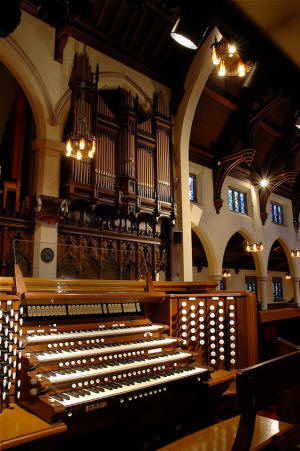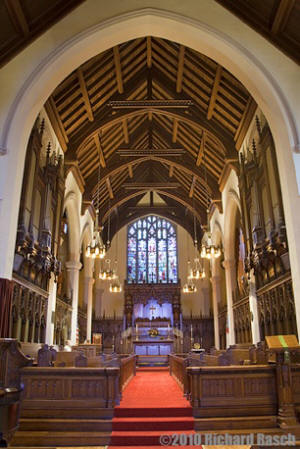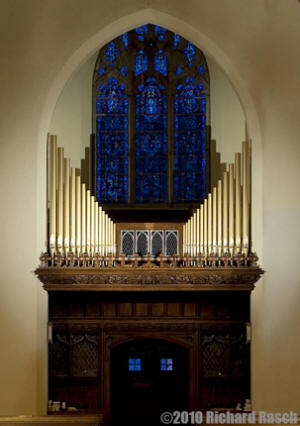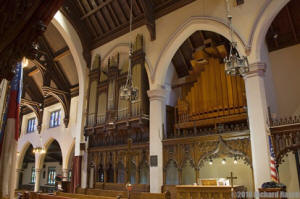|
Builder: Schantz Organ Co (2008) Manuals: 4 Ranks: 55 Stops: 47 Action: Electro-pneumatic Notes: 1921 - Installation by Skinner Organ Co 1950 - Rebuild, altered specification and new console by Moller Organ Co 2005 - New console by Schantz 2008 - Restoration, expansion and a new Antiphonal Division by Schantz. --Identified through information adapted from E. M. Skinner/Aeolian-Skinner Opus List, by Sand Lawn and Allen Kinzey (Organ Historical Society, 1997) THE DIAPASON, July 1922. Information from James Frazier, Director of Music. Photos from the “Pipedreams” website, Richard Rasch, photographer Last Update: 8/2012 |
 |
|
GREAT ORGAN 16 Double Diapason 12 8 First Open Diapason 61 8 Second Open Diapason 61 8 Bourdon (Sw) -- 8 Claribel Flute 61 8 Erzähler 61 4 Octave 61 2-2/3 Twelfth 61 2 Fifteenth 61 2 Mixture III 183 8 Tromba 61 8 Tuba (Solo) -- Chimes (Ch) Tower Bells SOLO ORGAN 8 Flauto Mirabilis 73 8 French Horn 73 8 Tuba 73 Tremolo Chimes (Ch) |
 |
|
SWELL ORGAN 16 Bourdon 73 8 Diapason 73 8 Salicional 73 8 Voix Céleste C 73 8 Gedeckt 73 8 Flauto Dolce 73 8 Flute Céleste c 49 4 Principal 73 4 Flute 61 2 Flautino 61 2 Mixture V 305 16 Waldhorn (from Cornopean) 12 8 Cornopean 73 8 Oboe 73 4 Clarion 73 8 Vox Humana (in separate box) 61 Tremolo |
 |
|
CHOIR ORGAN 8 Diapason 61 8 Viola 61 8 Dulciana 61 8 Unda Maris c 49 8 Concert Flute 61 4 Octave 61 4 Flute (harmonic) 61 2-2/3 Nazard (harmonic) 61 2 Piccolo (harmonic) 61 1-3/5 Tierce (harmonic) 61 8 Clarinet 61 8 Tuba (Solo) -- Chimes 20 |
 |
|
ANTIPHONAL ORGAN (floating) 8 Diapason 61 8 Gedeckt 73 4 Principal 61 4 Koppelflöte (from Gedeckt) -- 2 Superoctave 61 2 Fourniture III 183 |
PEDAL ORGAN 32 Resultant -- 16 Open Diapason 44 16 Diapason (Gt) -- 16 Bourdon 44 16 Echo Bourdon (Sw) 8 Octave (from Open Diapason 16) 8 Octave Diapason (Gt) 8 Gedeckt (from Bourdon 16) 8 Still Gedeckt (Sw) 4 Fifteenth 32 16 Trombone (wood) 44 16 Waldhorn (Sw) 8 Tromba (from Trombone 16) 8 Cornopean (Sw) 4 Clarion (from Cornopean) Chimes (Ch) ANTIPHONAL PEDAL 16 Gedecktbass (from Gedeckt) 12 8 Gedeckt |
|
A Casual History of St. John’s Organs and Organists The earliest organist at St. John’s was Robert Bethune, a pharmacist who volunteered his services to the church, but parish records also indicate that an organist was paid during 1884. In the following year, Mr. James Blaikie was thanked by the parish “for so kindly giving his services as organist for the past year.” Blaikie was a salesman for Nathan Ford, Pianos and Organs, at 96 East Third Street. St. John’s first organ was the Farrand and Votey instrument (installed in 1891) that served the parish at its first location, on the corner of Ashland Avenue and Mackubin Avenue (the church is extant). In 1903 the instrument was moved to the new Guild Hall (designed by Cass Gilbert) at Portland and Kent which served temporarily as the church. In time the organ began to fail, and the Rev. Dudley W. Rhodes, the rector from 1896 to 1900, recalled that the only dark memory of those years which abides with me is the way in which the organ refused to enter into the general harmony and fell into fits of sullenness and indifference at vital moments in the service. The organ was always fully alive and earnest in the Processional Hymn, slightly irritable and asthmatic in the Venite and flatly and violently rebellious in the Te Deum, finally giving a shudder and sinking into everlasting rest upon which a faithful delegation of hard worked minute men instantly seized the small organ in the vestry room, and rolled it tumultuously forward into the crowded church to the intense delight, imperfectly suppressed, of the younger portion of the congregation. Moreover, the greater part of the congregation sat between the organ and the choir, so that the organ sounded too loud to the congregation, but to the choir it was barely audible. By 1904, after the nave was added to the extant choir and chancel, there were nearly sixty boys and twenty-three men in the choir, making it one of the largest boy choirs in the country. The current organist, George Fairclough, wrote that a large choir was necessary because of the poor acoustics of the new church, and that a larger and more modern organ was badly needed. The Farrand and Votey lacked sufficient volume because it was too small and was shoved back in a chamber with a solid wall of masonry separating it from the main body of the church. Robert Hope-Jones was engaged to build a four-manual organ in the chancel, to be distinguished by “its churchliness and dignity of tone.” The plan called for three swell boxes (for the foundation stops, the swell and choir divisions, and for the tuba) constructed of cement and furnished with parabolic ceiling reflectors which would direct the sound into the chancel and nave. Each box was to be equipped with heavy laminated shutters and fitted with Hope-Jones’s patented sound-proof joints. The instrument was installed in 1910, with inclined manuals, having the features of “double-touch” and “suitable-bass,” with wind pressures ranging from five to twenty-five inches, and with a set of chimes placed in the basement. The console included preparations for the later addition of a two-manual and pedal echo organ, with sixteen stops, to be placed in the gallery over the center door, for the support of congregational singing. This part of the instrument was never constructed. By 1921, however, problems with the Hope-Jones organ began to appear, and the parish newsletter reported that the organ “persisted in ‘acting up’” at the evening service on Easter day of that year. By December it was clear that the organ would need to be replaced, and one of the longstanding members of the parish gave an unsolicited gift of $250 as a first contribution toward a new organ…only eleven years after the Hope-Jones instrument had been installed. A substantial gift by Arthur G. Rice, his daughter Katherine L. Rice and his son Arthur Ward, ensured the purchase of a new organ by Ernest M. Skinner of Boston, as a memorial to Kate Barber Ward Rice (a plaque to this effect is placed on the column in the middle of the choir on the left side of the chancel). This organ, like the earlier one, was to have a gallery division added later, but again it was never constructed. The new E.M. Skinner organ was first played by George Fairclough on July 8, 1922 in recognition of Fairclough’s twenty-first anniversary at St. John’s. Fairclough also headed the department of organ, piano, and theory at Macalester College and was for twenty years Professor of Music at the University of Minnesota. His Communion Service in A Flat and his Benedicite in G were said to have been used in many Episcopal churches across the country. He died on March 27, 1954. C. Wesley Andersen succeeded Fairclough as organist and choirmaster. In 1957 Andersen was also named Superintendent of Music for the Minneapolis Public Schools. He was a composer, arranger, conductor, ballet master, organizer and stage manager. Andersen retired from St. John’s in 1972, having served the parish for twenty-nine years. During Andersen’s tenure, the Möller Organ Company installed a new console and added a number of new ranks to the instrument, replacing the Skinner Tuba and Trombone with new ranks, moving the Choir diapason 8’ to the Swell division to play at 4’, and revoicing the Swell cornopean to a more trumpet-like character. The Swell mixture (which contained a tierce rank and did not break back) was moved to the Choir division as three independent ranks (2 2/3’, 2’, and 1 3/5’). New mixtures were added to the Swell and Great divisions, a new Fifteenth 4’ was added to the Pedal, and an Oboe 8’ and Clairon 4’ were added to the Swell. Möller’s purpose over all was to brighten the instrument; such efforts were fashionable in that era, to correct what were perceived as romantic faults. Andersen was succeeded in 1972 by Robert Kendall, an emeritus assistant professor of organ at St. Olaf College in Northfield. For many years heavy velvet drapes hung behind the two arches on either side of the chancel, immediately to the north of the beautifully carved façades. Since the organ pipes in those two chambers were not designed to be seen, the drapes served a visual function. But they also stifled the egress of sound from those same chambers. One day Mr. Kendall and his wife removed the drapes in order to improve the sound of the organ in the nave, stirring up clouds of old dust. The Kendalls still visit Saint John’s once in a while. (Robert L. Kendall died March 20, 2016, at age 83.) During the tenure of Gregory Larsen, a three-stage plan was developed to restore and enlarge the Skinner under the direction of well-known Skinner expert Sam Koontz of Ann Arbor, Michigan. The first stage—the releathering of the Solo chest and repairs to improve the speech of the Tuba and French Horn—was completed in 1987. The second stage would have restored the instrument to its original Skinner character, much as the recent work has accomplished, and the third stage would have installed a Gallery division in the balcony and new orchestral strings in the Solo division, but these two stages were not accomplished. Mr. Larsen holds a graduate degree in arts education from the University of Montana. He taught at Shattuck-St. Mary’s School in Faribault and at the Blake School. C. Wesley Andersen hired him to teach in the Minneapolis School System. Upon leaving St. John’s, Mr. Larsen went to Saint Stephen’s Episcopal Church in Edina. In 2006 he became organist at Ascension Episcopal Church in Denver, Colorado. (Gregory S. Larsen died of cancer March 10, 2012, at age 64.) Larry Blackburn was the next organist to serve St. John’s, and he is now the organist at First Presbyterian Church in Salt Lake City. He holds a masters degree in organ performance from Brigham Young University, has performed with the Utah Symphony, and plays regularly on the famed Aeolian-Skinner organ in the Tabernacle at Temple Square. Canon Musician, Howard Don Small was organist at St. Johns following Mr. Blackburn’s tenure, until 2004. He had been organist and choirmaster at St. Mark’s Episcopal Cathedral in Minneapolis for many years, where he distinguished himself for the caliber and scope of the cathedral’s music program, which featured major premieres and performances of epic choral works with orchestra, along with concerts by guest choirs and organists. Small established the Winifred Bean Evensong Fund at St. John’s, which enables the parish choir to sing evensong and present larger choral works three times each year, occasionally with orchestra. The Bean Fund also supports the presentation of Christmas Lessons and Carols. It was Mr. Small who first proposed that the time had come for decisive work to be done on the organ, to include the installation of an antiphonal organ. (Howard Don Small died July 13, 2007, at age 74.) The Organ Committee was formed shortly after James Frazier assumed the position of organist and choir director in 2004. Under the leadership of Joan Potter the commission recommended to the Vestry that the Schantz Organ Company, of Orrville, Ohio, be engaged to conduct the necessary cleaning and repairs of the existing pipe work, install a new console and a new antiphonal organ, and manufacture a number of new ranks. The contract was signed by Senior Warden Jeffrey J. Olsen in November 2006. An Organ Task Force, consisting of representatives of the Organ Committee and the Building Committee, and chaired by Rob Beattie, subsequently oversaw the work of preparing the balcony and the organ chambers, and of the installation of the completed instrument. On behalf of the Task Force, Dusty Mairs attended to myriad details on a nearly daily basis. Material for this history has been drawn from a number of sources in the archives of St. John’s Church, and from Church of St. John the Evangelist: Centennial History 1881-1981, by Robert Orr Baker, ed., and from “Robert Hope-Jones and Saint John the Evangelist Episcopal Church, Saint Paul, MN” by Nils Halker. |
|